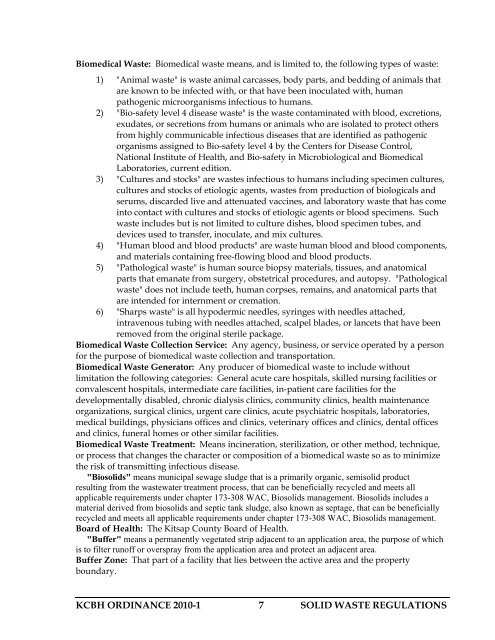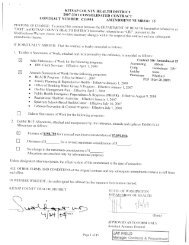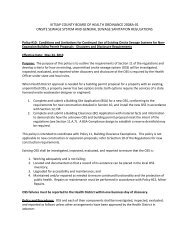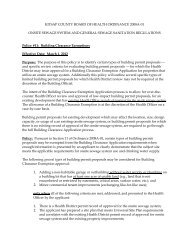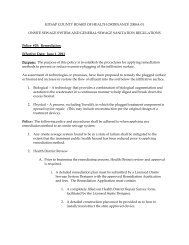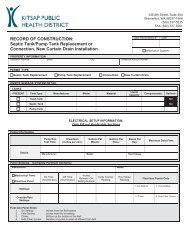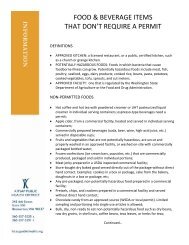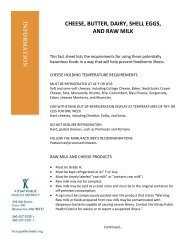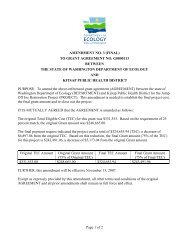SOLID WASTE REGULATIONS - Kitsap Public Health District
SOLID WASTE REGULATIONS - Kitsap Public Health District
SOLID WASTE REGULATIONS - Kitsap Public Health District
Create successful ePaper yourself
Turn your PDF publications into a flip-book with our unique Google optimized e-Paper software.
Biomedical Waste: Biomedical waste means, and is limited to, the following types of waste:<br />
1) "Animal waste" is waste animal carcasses, body parts, and bedding of animals that<br />
are known to be infected with, or that have been inoculated with, human<br />
pathogenic microorganisms infectious to humans.<br />
2) "Bio-safety level 4 disease waste" is the waste contaminated with blood, excretions,<br />
exudates, or secretions from humans or animals who are isolated to protect others<br />
from highly communicable infectious diseases that are identified as pathogenic<br />
organisms assigned to Bio-safety level 4 by the Centers for Disease Control,<br />
National Institute of <strong>Health</strong>, and Bio-safety in Microbiological and Biomedical<br />
Laboratories, current edition.<br />
3) "Cultures and stocks" are wastes infectious to humans including specimen cultures,<br />
cultures and stocks of etiologic agents, wastes from production of biologicals and<br />
serums, discarded live and attenuated vaccines, and laboratory waste that has come<br />
into contact with cultures and stocks of etiologic agents or blood specimens. Such<br />
waste includes but is not limited to culture dishes, blood specimen tubes, and<br />
devices used to transfer, inoculate, and mix cultures.<br />
4) "Human blood and blood products" are waste human blood and blood components,<br />
and materials containing free-flowing blood and blood products.<br />
5) "Pathological waste" is human source biopsy materials, tissues, and anatomical<br />
parts that emanate from surgery, obstetrical procedures, and autopsy. "Pathological<br />
waste" does not include teeth, human corpses, remains, and anatomical parts that<br />
are intended for internment or cremation.<br />
6) "Sharps waste" is all hypodermic needles, syringes with needles attached,<br />
intravenous tubing with needles attached, scalpel blades, or lancets that have been<br />
removed from the original sterile package.<br />
Biomedical Waste Collection Service: Any agency, business, or service operated by a person<br />
for the purpose of biomedical waste collection and transportation.<br />
Biomedical Waste Generator: Any producer of biomedical waste to include without<br />
limitation the following categories: General acute care hospitals, skilled nursing facilities or<br />
convalescent hospitals, intermediate care facilities, in-patient care facilities for the<br />
developmentally disabled, chronic dialysis clinics, community clinics, health maintenance<br />
organizations, surgical clinics, urgent care clinics, acute psychiatric hospitals, laboratories,<br />
medical buildings, physicians offices and clinics, veterinary offices and clinics, dental offices<br />
and clinics, funeral homes or other similar facilities.<br />
Biomedical Waste Treatment: Means incineration, sterilization, or other method, technique,<br />
or process that changes the character or composition of a biomedical waste so as to minimize<br />
the risk of transmitting infectious disease.<br />
"Biosolids" means municipal sewage sludge that is a primarily organic, semisolid product<br />
resulting from the wastewater treatment process, that can be beneficially recycled and meets all<br />
applicable requirements under chapter 173-308 WAC, Biosolids management. Biosolids includes a<br />
material derived from biosolids and septic tank sludge, also known as septage, that can be beneficially<br />
recycled and meets all applicable requirements under chapter 173-308 WAC, Biosolids management.<br />
Board of <strong>Health</strong>: The <strong>Kitsap</strong> County Board of <strong>Health</strong>.<br />
"Buffer" means a permanently vegetated strip adjacent to an application area, the purpose of which<br />
is to filter runoff or overspray from the application area and protect an adjacent area.<br />
Buffer Zone: That part of a facility that lies between the active area and the property<br />
boundary.<br />
KCBH ORDINANCE 2010-1 7 <strong>SOLID</strong> <strong>WASTE</strong> <strong>REGULATIONS</strong>


